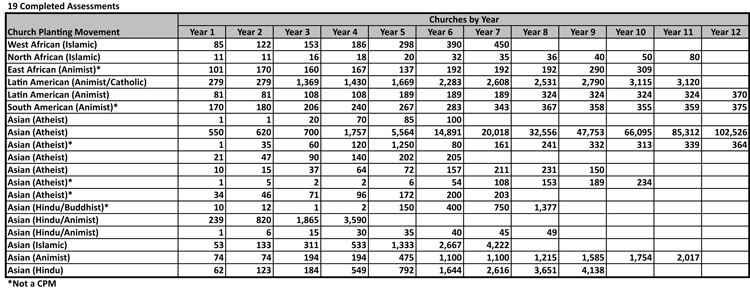Just How Many Church Planting Movements Are There?

Today, “Church Planting Movements” (“CPMs”) continue to be a hot topic among church planting practitioners and missiologists. Numerous articles and books have debated CPMs and pondered unbelievable reports of CPM breakthroughs among people groups. The articles in this edition speak to the continuing interest in CPMs.
Eventually, someone wants to know if anyone has “looked inside” a CPM. Others ask, “If they exist, how many are there in the world today?” This article provides an answer to this question.
In order to answer the question before us, let us focus on our definition—“a CPM is a rapid multiplication of indigenous churches planting churches that sweeps through a people group or population segment.” I repeat the definition here because some have altered this definition over the past few years.
When generations of local church members multiply churches to the extent that the total number of churches doubles every four to six years, a CPM likely exists. Multiplication of new churches results in new “streams” of a CPM within a people group, and this multiplication corresponds to the presence of key CPM universals. For example, assessed CPMs reveal that church leadership arises from within new churches and is not dependent on hired church planters and missionaries, even if Christian workers from the outside provide the initial training. If church multiplication is going to sweep through people groups, helpers must avoid methodologies contrary to universals that are commonly found in CPMs.
In the early 1990s, David Garrison and other missionaries began to observe streams of multiplying churches within ethnolinguistic people groups. They also realized that existing missiological and church growth terms, such as “Church Growth Movement,” “Great Awakening”, and “Revival of Christians and Christianity” did not adequately describe them. After examining some of these streams, “Church Planting Movements” seemed to describe the phenomenon of multiplication of indigenous churches within a people group or population segment. These CPMs resemble Mark’s description of Christ’s Parable of the Sower, Seeds and Soils that resulted in thirty-fold, sixty-fold and one-hundred-fold multiplication. (Mark 4:1-20)
In 2000, I became Consultant for Field Services and Assessments in IMB’s Global Research and tasked with assessing CPMs. Concisely, my responsibilities included the examination of reported CPMs around the world.
Since 2000, IMB teams have completed nineteen on-site CPM assessments. Thirteen of these have proven to be CPMs; six have not. Six did not show evidence of generational multiplication of indigenous churches planting churches. Without revealing the identity of specific people groups, the following chart provides a longitudinal view of total churches reported by year within each of the CPM assessments conducted.

Bountiful notes back each of the CPM assessments, and many include results from interviews recorded on thousands of spreadsheets. The spreadsheets provide details about amazing CPM dynamics through the year of the CPM interviews for each assessment. Beyond the numbers, each interview provides fine points of lives changed by Jesus Christ and the dynamics of powerful breakthroughs in difficult places.
The reader will likely ask, “Beyond the thirteen confirmed CPMs assessed by IMB, how many additional CPMs exist today?” An attempt to provide a “ballpark answer” follows.
Since 1845, IMB personnel on the field have completed an Annual Statistical Report (ASR). In any given year, team strategy leaders among people groups and population segments around the world submit more than 2,000 of these reports. Field personnel submit additional information about Evangelical congregations and believers among people groups. These reports help to identify emerging CPMs.
Five years ago, IMB’s Global Research identified 42 emerging CPMs. As a rule, we look for 50% annual growth rate in new churches; 25% annual growth rate in total churches and/or other field support for an emerging CPM. Four years ago, the number grew to 72. Last year, we identified just over 200 possible CPMs.
Obviously, we cannot assess all of the possible CPMs ourselves. We need to train new assessment teams using lessons learned from existing CPMs. As such, IMB is willing to include non-IMB experts on CPM assessment teams and to provide CPM assessment training for organizations committed to seeing CPM-oriented church planting among people groups.
We have learned much about practices and methodologies common to CPM practitioners. These practices enhance the possibility of seeing a CPM. On the other hand, we have learned that there are practices and methodologies common to those who are not likely to experience a CPM. God is moving in amazing ways today for His glory, and as we learn from what he is doing, we urge church planters to implement CPM-oriented strategies.
1 Total churches reported reflects findings of CPM assessment teams; not initial reports. Additionally, as a CPM grows and expands our ability to describe accurately the size and scope of the movement decreases. Since we do not report numbers of churches that cannot be verified in a CPM assessment, numbers reported may appear to plateau, but this is more a product of verification methodology than a reflection of a stalling CPM. Other methodologies for understanding the expansion of CPMs depend on strategic markers or “genomes.” For example, if interviews reveal that a certain sequence of Bible verses, Bible stories, and training methodologies were used to train the first generation of church planters and interviews in other parts of the country reveal this same sequence in the testimonies of believers, we can predict that they are a continuation of the original generation.








comments